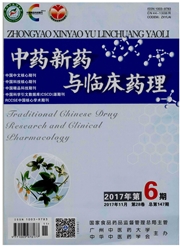

 中文摘要:
中文摘要:
目的运用代谢组学方法探讨刺五加多糖对免疫性肝损伤小鼠的保护作用,寻找潜在的生物标志物并分析其代谢途径,探讨其作用机制。方法将30只KM种小鼠随机分为3组,即空白组、刀豆蛋白A(Con A)模型组及刺五加多糖给药组(14.5 mg·mL^-1),空白组和模型组给予生理盐水(10 mg·mL^-1),刺五加多糖给药组给予刺五加多糖(14.5 mg·mL^-1),连续灌胃7 d。除空白组外,各给药组于第7天末次给药4 h后,尾静脉注射Con A水溶液(2.5 mg·m L^-1),禁食不禁水8 h后取肝脏及脾脏,样品经处理供UPLC-Q-TOF/MS分析。本实验采用Micromass Marker Lynx软件进行色谱峰识别以及峰匹配,并采用主成分分析法(PCA)和正交偏最小二乘-判别分析法(OPLS-DA)对获得的多维复杂数据进行降维处理,并通过变量重要性投影(VIP)在肝脾中选取生物标志物及查找其代谢途径。结果从肝脾中共鉴定出谷胱甘肽、左旋肉碱等22个潜在生物标志物,并且与半胱氨酸和蛋氨酸代谢、柠檬酸循环及胆汁的分泌等代谢通路有关。结论刺五加多糖对免疫性肝损伤小鼠具有一定的保护作用,其作用机制可能与氧自由基和一些细胞因子等相关。
 英文摘要:
英文摘要:
Objective To investigate the protective effect of Acanthopanax senticosus polysaccharides(ASP) on immunological liver injury in mice,thus to find the potential biomarkers and to analyze the metabolic pathways for the exploration of therapeutic mechanism.Methods Thirty KM mice were randomly divided into 3 groups,namely blank control group,model group and ASP group.The blank control group and model group were orally given normal saline10 mg·m L^-1,and ASP group was orally given ASP 14.5 mg·m L^-1for 7 days.Except for the blank control group,the other two groups were given intravenous injection of the aqueous solution of concanavalin A(Con A,2.5mg·m L^-1)through the caudal vein 4 hours after the last medication at the seventh day.After fasting for 8h,the mice were executed,and the liver and spleen were sampled for the analysis of UPLC-Q-TOF/MS.The Micromass Marker Lynx software was adopted for the identification of chromatographic peak and peak matching.The principal component analysis(PCA) and the orthogonal partial least-squares discriminant analysis(OPLS-DA) were applied to dimension-reduction treatment of the complex multi-dimensional data,and the variable importance in the projection(VIP)was used for the screening of biomarkers and metabolic pathways in the liver and spleen.Result Twenty-two potential biomarkers such as glutathione and L-carnitine were identified from the liver and spleen.The effect was correlated to the metabolic pathways of cysteine and methionine metabolism,citrate cycle and bile secretion.Conclusion ACP has protective effect on immunological liver injury in mice.The potential biomarkers related to its mechanism may be oxyradicals and some cytokines.
 同期刊论文项目
同期刊论文项目
 同项目期刊论文
同项目期刊论文
 期刊信息
期刊信息
